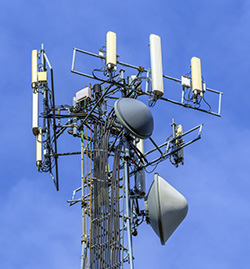Leak Testing of Electronics Housing Boxes
Description of Technical Challenge

Cell tower with electronic communications equipment
An electronics housing box, usually made of plastic or aluminum, consists of a case, electronics and some connectors or feedthroughs.
These boxes are used in a wide range of outdoor applications such as advanced information and communications equipment (radio base stations and antennas, telephone masts etc.) and home appliances (electrical lawn mowers, security alarm systems). Designed for use outdoors, the electronics housing boxes must be humidity tight (weatherproof). They normally meet the IP67 standard and are tested to leak rates in the 5x10-4 – 5x10-3 mbar l/s range.
Leak testing of assembled electronics housing boxes can be done by pressurizing the component with air followed by soaping. After the soap is applied, each point which can potentially leak is inspected visually. The negative effects of soaping are:
- In presence of large leaks soap can damage electronics.
- Need to clean up and dry the boxes after leak test.
- In presence of large leaks the soap spray can be blown away from the leak site, and in the case of multiple leaks close to each other, it will be difficult to determine the size of each leak.
- Smallest leaks (close to the IP67 specification) cannot be detected with soaping.
- Operator dependent leak test.
- Requires line-of-sight.
The INFICON Solution
Leak testing assembled electronics housing boxes
Two options are available for leak testing assembled electronics housing boxes:
Automated, integral testing (accumulation testing) with helium tracer gas
Sensistor Sentrac Hydrogen Leak Detector and TGF11 Tracer Gas Filler
Before leak testing, the housing is filled with tracer gas. Filling the housing should be done in a way that ensures a maximum concentration of tracer gas on the inside. The TGF11 Tracer Gas Filler by INFICON evacuates the air before filling and ensures that the tracer gas reaches all parts inside the product.
For automated integral testing of electronic boxes, the housing is filled with helium and put in a chamber that closes and seals. If the housing has a leak, helium will leave the housing through the leak and accumulate inside the chamber over time. The consequent increase in helium concentration will be detected with the T-Guard accumulation leak detector.
If any leak is detected, the electronics enclosure box can be taken from the chamber and points of interest can be scanned with a Protec P3000 (XL) leak detector to locate the exact position.
Leak testing in predefined areas with hydrogen tracer gas
Before leak testing, the housing is filled with tracer gas as described earlier. Once filling with tracer gas is completed, the leak testing can begin. All points of interest are scanned by moving the sniffing hand probe of the Sensistor Sentrac Hydrogen Leak Detector across those areas. If any leak occurs, the forming gas will escape from the leak and be detected by the leak detector. The exact leak location can be determined by moving the probe tip back and forth and is found where the highest leak rate is shown. After locating a leak, the operator can obtain leak measurements and determine if the housing is tight or not. When the test is complete the TGF11 Tracer Gas Filler releases tracer gas in a controlled way avoiding contamination of the test area.
Leak testing can also be performed combining pressure decay (for those parts suited for this testing method) and tracer gas method. A pressure decay test will reveal the presence of any leaks. If leaks are present, the pressure decay test can be followed by manual leak locating with tracer gas to pinpoint the exact leak position.
Benefits of Hydrogen/Helium Leak Testing
- Fast pinpointing of the leak position
- No operator interpretation of the leak size - precise measurement obtained
- Reliably detect even the smallest leaks close to the leak rate limit
- Volume independent test - suitable for testing soft/flexible components
- No time wasted in cleaning up or drying after testing
- Easy to find leaks even with limited visual access
For best leak limits and more detailed information about leak detection on electronics housing boxes, contact the INFICON sales office nearest to you.